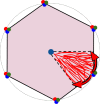The liver, a functionalized vascular structure
- PMID: 33004881
- PMCID: PMC7531010
- DOI: 10.1038/s41598-020-73208-8
The liver, a functionalized vascular structure
Abstract
The liver is not only the largest organ in the body but also the one playing one of the most important role in the human metabolism as it is in charge of transforming toxic substances in the body. Understanding the way its blood vasculature works is key. In this work we show that the challenge of predicting the hepatic multi-scale vascular network can be met thanks to the constructal law of design evolution. The work unveils the structure of the liver blood flow architecture as a combination of superimposed tree-shaped networks and porous system. We demonstrate that the dendritic nature of the hepatic artery, portal vein and hepatic vein can be predicted, together with their geometrical features (diameter ratio, duct length ratio) as the entire blood flow architectures follow the principle of equipartition of imperfections. At the smallest scale, the shape of the liver elemental systems-the lobules-is discovered, while their permeability is also predicted. The theory is compared with good agreement to anatomical data from the literature.
Conflict of interest statement
The authors declare no competing interests.
Figures






Similar articles
-
Anatomically based simulation of hepatic perfusion in the human liver.Int J Numer Method Biomed Eng. 2019 Sep;35(9):e3229. doi: 10.1002/cnm.3229. Epub 2019 Jul 31. Int J Numer Method Biomed Eng. 2019. PMID: 31368204
-
[Hepatic circulation: anatomical and physiological analysis with reference to its clinical importance].Rev Med Chil. 1984 Oct;112(10):1044-51. Rev Med Chil. 1984. PMID: 6536080 Spanish. No abstract available.
-
Hierarchical Modeling of the Liver Vascular System.Front Physiol. 2021 Nov 16;12:733165. doi: 10.3389/fphys.2021.733165. eCollection 2021. Front Physiol. 2021. PMID: 34867439 Free PMC article.
-
Liver hemodynamics and portacaval shunt.Surg Gynecol Obstet. 1980 Apr;150(4):587-92. Surg Gynecol Obstet. 1980. PMID: 6987756 Review.
-
Pathophysiology of liver circulation with an overview of medical and invasive treatments.Rays. 1997 Apr-Jun;22(2):196-210. Rays. 1997. PMID: 9351328 Review. English, Italian.
Cited by
-
The Influence of Interdisciplinary Work towards Advancing Knowledge on Human Liver Physiology.Cells. 2022 Nov 21;11(22):3696. doi: 10.3390/cells11223696. Cells. 2022. PMID: 36429123 Free PMC article. Review.
-
Assessing Enhanced Acoustic Absorption From Sonosensitive Perfluorocarbon Emulsion With Magnetic Resonance-Guided High-Intensity Focused Ultrasound and a Percolated Tissue-Mimicking Flow Phantom.Ultrasound Med Biol. 2023 Jul;49(7):1510-1517. doi: 10.1016/j.ultrasmedbio.2023.01.022. Epub 2023 Apr 26. Ultrasound Med Biol. 2023. PMID: 37117139 Free PMC article.
-
Toward better drug development: Three-dimensional bioprinting in toxicological research.Int J Bioprint. 2023 Jan 6;9(2):663. doi: 10.18063/ijb.v9i2.663. eCollection 2023. Int J Bioprint. 2023. PMID: 37065668 Free PMC article. Review.
-
Acoustofluidic Engineering of Functional Vessel-on-a-Chip.ACS Biomater Sci Eng. 2023 Nov 13;9(11):6273-6281. doi: 10.1021/acsbiomaterials.3c00925. Epub 2023 Oct 3. ACS Biomater Sci Eng. 2023. PMID: 37787770 Free PMC article.
-
Regulation of systemic metabolism by tissue-resident immune cell circuits.Immunity. 2023 Jun 13;56(6):1168-1186. doi: 10.1016/j.immuni.2023.05.001. Immunity. 2023. PMID: 37315533 Free PMC article. Review.
References
-
- Bejan A. The Physics of Life: The Evolution of Everything. New York: St. Martin’s Press; 2016.
-
- Landes, G. Einige Untersuchungen an elektrischen Analogieschaltungen zum Kreislaufsystem. In Zeitschrift für Biologie 101 (J.F. Lehmann Verlag, München-Berlin, 1943).
MeSH terms
LinkOut - more resources
Full Text Sources
Miscellaneous

